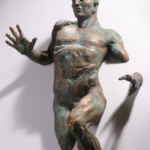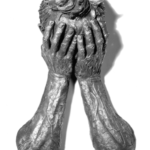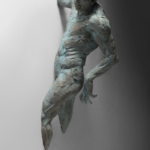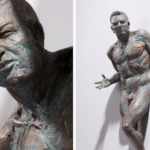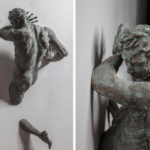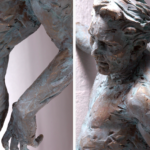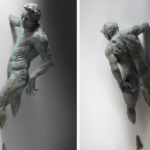
Artist Bio
Matteo Pugliese was born in Milan in 1969. In 1978 his family moved to Sardinia where Matteo lived for the next 12 years. During this time he developed a strong love for drawing and sculpture and continued his artwork without any formal education. After finishing his secondary school studies in classics in Cagliari, he returned to Milan to attend the University.
In 1995 he was awarded his degree in Modern literature at the University of Milan with a graduation thesis on art criticism.
Encouraged by friends, in 2001 he organized and financed his first solo exhibition, renting private exhibition space in the center of Milan. Only 18 months later he held his first “official” exhibition in a gallery in Brera, Milan, and, after a few months, he had a solo show in Brussels.
Today his works are on permanent display in galleries in Italy and in major cities throughout the world including New York, Rome, Hong Kong, London, Antwerp, Lugano; and they have been shown at some of the most important Italian and international art fairs such as the Hong Kong Art Fair (Hong Kong), Art First (Bologna), Arco (Madrid), and FIAC (Paris).
In recent years his pieces have been sold with considerable success at some of the world’s most prestigious fine art auction houses (Christie’s, Sotheby’s, Bonham’s, and Dorotheum).
Matteo Pugliese is married with one daughter. He lives in Milan and Barcelona.
INTERVIEW
Artist: Matteo Pugliese

What is your daily work-routine?
I’m not a morning-person, therefore mornings are dedicated to answering mail, phone calls, the usual “office” routine. The afternoon is pure creation. The world outside ceases to exist, and I do not allow anyone to interfere with my inspiration. I sort of switch into “airplane mode.”


What is the most indispensable item in your studio?
I don’t need any particular item to create. For me, the only indispensable element is solitude. Because I don’t want to be interrupted, and sculpting is sort of a meditation for me, I don’t work with assistants. I am the one who dictates the rhythm and decides when to stop–or start doing something completely different.
Do you listen to or watch any form of media while working? If so, what? And how does it influence your process?
Music has always been an important part of my life. I have several thousand songs on my old iPod. I love artists like Tom Waits, Leonard Cohen, Bruce Springsteen, Keith Jarrett, Cesaria Evora, Velvet Underground, John Coltrane, Mercedes Sosa, and some Italian artists. This is all music that clearly defines my age. I think that music has influenced me more than other media, maybe even more than sculpture itself.

What do you believe is the key to creating a good sculpture?
To be unafraid of risks and mistakes and to make sculptures for yourself rather than for the art ecosystem.

Milan is a city with a rich history. How much does its history, its political and social aspects influence your art?
My family and my country have influenced my passion and style the most. Even at first glance, one can see that my works are strictly linked to Classic and Renaissance Italian production.

Your “Extra Moenia” series is full of physical strength, and the figures seem to be breaking out of traps and repressions. They overcome imprisonment, obstacles, and boundaries. Does all that relate to your own experiences?
Yes indeed. The theme of imprisonment versus freedom is very dear to me. I have seen around me many people who live lives not theirs, people who unfortunately have never had the chance or found the strength to express themselves, people who deny or fail to nourish their true selves, be it professional, sexual, or social.
When you look back over your career, do you think particular character traits have dominated your work?
Passion for my work–and determination, probably.
Your favorite quote is…
I’ve recently read a quote of Win Borden that I like: “If you wait to do everything until you’re sure it’s right, you’ll probably never do much of anything”.


